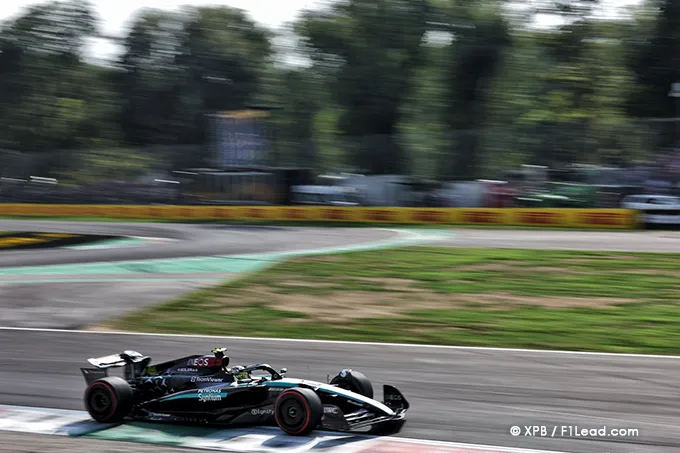Lewis Hamilton missed a crucial pole at Monza due to a less-than-perfect final lap, ending up sixth.
Mercedes F1 was the third force at Monza, yet the team could have performed better in qualifying, as Lewis Hamilton stated after missing his fast lap in Q3. Andrew Shovlin, the trackside engineering director, confirms that the W15 had the pace to aim for the pole position.
“I’m sure we could have done a bit better,” Shovlin remarked. “And the origin of Lewis’s frustration is clear when you look at the GPS data and see that approaching the last corner, we were half a tenth from Lando and his pole lap.”
“However, the last corner didn’t go particularly well for Lewis. He lost a bit of time there, and without that, he could have easily been on the front row, even contending for the pole position.”
“What we’ve seen in the last few races, though, is that the struggles for the top of the grid actually extend to the seventh or eighth place. There are so many cars within two tenths of a second, and it’s the kind of margin where everything hinges on the drivers’ ability to complete their lap.”
“And what’s frustrating for Lewis is that he showed great pace in Q2, he didn’t pull off his last lap in Q3, and he can drop to sixth place. That’s how tight the situation is right now.”
A floor that poses “a tough question”
Since the introduction of the new floor, Mercedes has been trying to determine how effective it is. The engineer assures, however, that its potential and gains are already evident, but it remains to ensure that the maneuverability of the W15 is not impacted.
“Over the last three races, we’ve conducted various comparisons of the setups and primarily the floor, and we’re confident it produces the load we expect. How do we know? We measure the forces it generates on the road through the suspension.”
“We also examine the pressures generated on the car, and we can correlate this with what we observe in the wind tunnel, which gives us a fairly precise idea of how the car is meeting our expectations.”
“It is important to note that this isn’t a major gain that we were expecting; it’s a small package that we introduced, but we are confident that it generates this load.”
“The toughest question we need to answer is this: is there something subtle that we didn’t anticipate in the handling characteristics of this setup?”
A general form “difficult to assess”
Mercedes has experienced three very different weekends at Spa, Zandvoort, and Monza, and Shovlin acknowledges that it’s hard to predict what to expect in Baku: “It’s quite difficult to assess because the car behaves differently from one circuit to another.”
“On some circuits, it performs very well, while on others, we’ve struggled to balance the car, regardless of the aerodynamic features. And, yes, the last two races weren’t as good as some of the previous ones.”
“It may just be the normal variation from one circuit to another, but that’s what we’ll be examining over the next few days, and in addition to that, there are other updates that we’re bringing to the system.”
“There’s a lot to consider, but we now have a large amount of data, and we can use the next few days to maximize what we learn from it.”

- You may also like>Red Bull Unsure of Verstappen for 2026
- Also make sure you follow us on social media>Facebook and>Twitter
Hamilton’s Pole Hopes Dashed by Suboptimal Lap Hamilton’s Pole Hopes Dashed by Suboptimal Lap
